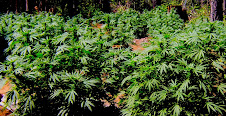The role played by terpenes in our bodies and circulating throughout the Earth's ecosystem are analogous. Terpenes have been a point of interest for me since 1997, when I was introduced to Cannabis terpenes by my friend Vito Mediavilla, eminent research scientist at the Swiss Federal Research Station near Bern.
Since then I learned about the physical dynamic of terpenes, that rise into the atmosphere, where they perform several critically important environmental services.
As they ascend into the stratosphere, terpenes reflect solar UV-B radiation away from the planet and serve as cloud condensation nuclei, forming "bright and persistent clouds." (3)
As a component of the hydrologic cycle, terpenes may play an increasingly significant role in purifying water of pathogens, that may be increasing as the concentration of terpenes is reduced by deforestation and death of marine phytoplankton.
"Pentacyclic triterpenes such as β-amyrin and cycloartenol have been shown to possess numerous biological activities including anti-bacterial, anti-fungal, anti-inflammatory and anti-cancer properties (Vázquez et al., 2012; Moses et al., 2013). These triterpenes are key contributors to the pharmacological properties of numerous medicinal herbs (Kirby et al., 2008; Yadav et al., 2010; Sawai and Saito, 2011)." (2)
Now, think about how...
"From 2012 to 2015, pathogenic versions of the fungus Candida auris arose independently in Africa, Asia and South America. The versions are from the same species, yet they are genetically distinct, so the spread across continents couldn’t have been caused by infected travelers, says Arturo Casadevall of the Johns Hopkins Bloomberg School of Public Health." (1)
"Since mid-2016, when reporting of C. auris infections began in the United States, there have been nearly 700 cases confirmed in 12 states, with deadly outbreaks occurring among patients in hospitals and other health care facilities. More than 30 countries around the world have also reported cases. The fungus causes dangerous infections of the blood, brain, heart and other parts of the body. Studies show that an invasive infection can be fatal 30 to 60 percent of the time. And some infections are resistant to all available antifungal medications." (1)
"Meanwhile, other fungi are wreaking destruction on many animals and plants, including frogs (SN: 4/27/19, p. 5), snakes (SN: 1/20/18, p. 16) and trees (SN: 5/3/03, p. 282). “A lot of our fellow creatures are being wiped out,” Casadevall says. And while mammals have tended to be “remarkably resistant to invasive fungal diseases,” he says, bats have been hit hard by outbreaks of a fungus that causes white nose syndrome in part because their body temperature drops during hibernation (SN Online: 7/15/19)." (1)
Recently it was reported that "An astonishing number of viruses are circulating around the Earth's atmosphere -- and falling from it" (4)
It seems to me that there is an urgent necessity of replenishing the Earth's atmosphere with terpenes, largely overlooked by those people concerned with climate change. #Cannabis #hemp is being revealed as a "Gaiatherapeutic" remedy needed to heal Earth's atmosphere of immune suppressive, Earth-broiling UV-B radiation, and airborne bio-pathogens.
How long will it take to conduct the global conversation that’s needed to heal this planet and human society?
###
References
1. Climate change could raise the risk of deadly fungal infections in humans
Outbreaks of Candida auris have recently erupted around the world
BY AIMEE CUNNINGHAM 6:00AM, JULY 26, 2019
https://www.sciencenews.org/article/climate-change-could-raise-risk-deadly-fungal-infections-humans
2. Cannabis sativa: The Plant of the Thousand and One Molecules
Christelle M. Andre, Jean-Francois Hausman, and Gea Guerriero
https://www.ncbi.nlm.nih.gov/pmc/articles/PMC4740396/
3. Fragrance of pine forests helps to slow climate change
James Randerson, 13 Apr 2006
https://www.theguardian.com/science/2006/apr/14/environment.climatechange
4. Viruses -- lots of them -- are falling from the sky
An astonishing number of viruses are circulating around the Earth's atmosphere -- and falling from it
February 6, 2018 University of British Columbia
https://www.sciencedaily.com/releases/2018/02/180206090650.htm
skip to main |
skip to sidebar

Drugs don't make seeds. Herbs do.

Here the spacing between hemp stalks is even more apparent. Inches apart, not feet.

Marijuana plants are multi-branched, planted six feet apart.

This is a field of marijuana. Note these are multi-branched, exclusively female, grown with plenty of room between each plant.

This is "industrial hemp" grown in vast swaths, planted inches apart, pollen-producing males & seeded females mixed. Pollen from this field would make seeds in marijuana plants, rendering them much less salable on the black market. If the DEA really wanted to impact the marijuana trade they wouldn't be pulling up feral hemp in the midwest, they'd be encouraging American farmers to plant hemp, to naturally balance high- and low-THC producing strains of Cannabis.


Competition from chemically-based industries are the true motivation behind prohibition of industrial hemp.
14. Barack Obama, Executive Order 13603 - National Defense Resources Preparedness
17.Strategic and Critical Materials 2013 Report on Stockpile Requirements
http://mineralsmakelife.org/assets/images/content/resources/Strategic_and_Critical_Materials_2013_Report_on_Stockpile_Requirements.pdf

Preying Mantis licking hemp resin
Freedom to farm "every herb bearing seed" is the first test of religious freedom. How bad do things have to get before all solutions are considered?
PayPal
Help me help you help everyone...
If you find value in this work, please feel invited to share the good news, or if you can, lend practical support using PayPal. There is something we all can do to heal our Mother Earth. One person can make a difference but one person can’t make a difference by themselves. 🙏
Cannabis is essential not illegal.

Drugs don't make seeds. Herbs do.
Hemp harvesting in France

Here the spacing between hemp stalks is even more apparent. Inches apart, not feet.
Can you tell the difference...?
Marijuana plants are multi-branched, planted six feet apart.
"Swiss mix" marijuana

This is a field of marijuana. Note these are multi-branched, exclusively female, grown with plenty of room between each plant.
Harvesting Hemp, Noirmoutier, France 2003

This is "industrial hemp" grown in vast swaths, planted inches apart, pollen-producing males & seeded females mixed. Pollen from this field would make seeds in marijuana plants, rendering them much less salable on the black market. If the DEA really wanted to impact the marijuana trade they wouldn't be pulling up feral hemp in the midwest, they'd be encouraging American farmers to plant hemp, to naturally balance high- and low-THC producing strains of Cannabis.
"In God We Trust"
Mission Statement
The mission of the California Cannabis Ministry is to identify Cannabis agriculture as integral to a free society and essential for human survival.
Boreal Forests of the world, "The Taiga" Region
Hemp climate zone map

A word from brother Paul
The real money

Competition from chemically-based industries are the true motivation behind prohibition of industrial hemp.
Start your own individual ministry.
The California Cannabis Ministry is meant to serve everyone, as an individual expression of our Article One, Bill of Rights, "First Freedom." The freedom of religion afforded by the United States Constitution secures our natural, god-given, self-evident rights that are also also guaranteed by several international human rights treaties.
Anyone who has genuine appreciation for the Cannabis plant, for any or all of its many uses and benefits, is reminded that deep in our hearts, we are all our own ministers. I trust that others will be inspired by my example, but everyone makes their own choices. California Cannabis Ministry encourages everyone to start their own individual ministries. I believe it is spiritually and legally meaningful for each of us to openly claim our rightful place in the most ancient, truly global Cannabis culture, even if doing so is judged an act of "civil disobedience" by unobjective courts.
It is recommended that you read this entire website for the research and knowledge being passed on. The THC Ministry website also offers a wealth of essential information. You are invited to write to projectpeace@gmail.com to subscribe to the ministry newsletter and join the discussion.
"Freedom of religion is the freedom of an individual or community, in public or private, to manifest religion or belief in teaching, practice, worship, and observance. It is generally recognized to also include the freedom to change religion or not to follow any religion. Freedom of religion is considered by many in many nations and people to be a fundamental human right." -- Wikipedia
Anyone who has genuine appreciation for the Cannabis plant, for any or all of its many uses and benefits, is reminded that deep in our hearts, we are all our own ministers. I trust that others will be inspired by my example, but everyone makes their own choices. California Cannabis Ministry encourages everyone to start their own individual ministries. I believe it is spiritually and legally meaningful for each of us to openly claim our rightful place in the most ancient, truly global Cannabis culture, even if doing so is judged an act of "civil disobedience" by unobjective courts.
It is recommended that you read this entire website for the research and knowledge being passed on. The THC Ministry website also offers a wealth of essential information. You are invited to write to projectpeace@gmail.com to subscribe to the ministry newsletter and join the discussion.
California Cannabis Ministry BlogTalkRadio Show
Recommended Reading
- National Institute on Drug Abuse, Final Report, 1991-1994 http://www.thc-ministry.org/NIDA_Report.jpg
- The Economics of Prohibition, Dr. Mark Thornton
- The Emperor Wears No Clothes, Jack Herer
- The Jefferson Bible, Thomas Jefferson
UV Index
Additional References:
1. The Ho‘omaluhia or "Peacemaker" Award
2. First Freedom Project
3. US HI: OPED: 'Ice' Addiction Is Booming, Thanks To Anti-Pot Efforts
Pubdate: Tue, 2 Sep 2003
Source: Honolulu Star-Bulletin (HI)
4. 1991-94 Final Report, "Ice and Other Methamphetamine Use: An Exploratory Study"
4. An Open Letter to Hon. MICHAEL B. SHAPIRO, FLORENCE T. NAKAKUNI! and MICHAEL K. KAWAHARA
5. Cannabis vs. "Global Broiling": An Inconvenient Solution
*References to "essential civilian demand" in government documents
*6. 44 C.F.R. PART 334—GRADUATED MOBILIZATION RESPONSE
Title 44 - Emergency Management and Assistance,
§ 334.6 Department and agency responsibilities. (f)
*7. THE DEFENSE PRODUCTION ACT OF 1950,AS AMENDED[50 U.S.C. App. § 2061 et seq.]Title VII - General Provisions Sec. 708. VOLUNTARY AGREEMENTS AND PLANS OF ACTION FORPREPAREDNESS PROGRAMS AND EXPANSION OF PRODUCTIONCAPACITY AND SUPPLY [50 U.S.C. App. § 2158] Page 2, paragraph 1
http://www.fema.gov/library/viewRecord.do?id=3590
[Also, see #13. William J. Clinton Executive Order 12919 below]
8.Franklin D. Roosevelt Executive Order 9280 - December 5, 1942
Delegating Authority Over the Food Program.
9. Harry S. Truman Executive Order 10161 - September 9, 1950
Delegating Certain Functions of the President Under the Defense Production Act of 1950
10. Dwight D. Eisenhower Executive Order 10480-- August 14, 1953
Further providing for the administration of the defense mobilization program
11. John F. Kennedy Executive Order 10998 - February 16, 1962
ASSIGNING EMERGENCY PREPAREDNESS FUNCTIONS TO THE SECRETARY OF AGRICULTURE
12. Richard Nixon Executive Order 11490 - October 28, 1969 -Assigning Emergency Preparedness Functions to Federal Departments and Agencies
*13. William J. Clinton Executive Order 12919 - June 3, 1994
National Defense Industrial Resources Preparedness
15. American Presidency Project
16. MANAGING TERRORISM’S CONSEQUENCES: LEGAL ISSUES http://www.law.depaul.edu/centers_Institutes/ihrli/downloads/managing_terrorisms_consequences.pdf
17.Strategic and Critical Materials 2013 Report on Stockpile Requirements
MantisOnMarijuana

Preying Mantis licking hemp resin
Help me help you help everyone...
If you find value in this work, please feel invited to share the good news, or lend practical support using the PayPal button below, that there is something we all can do to heal our Mother Earth.









